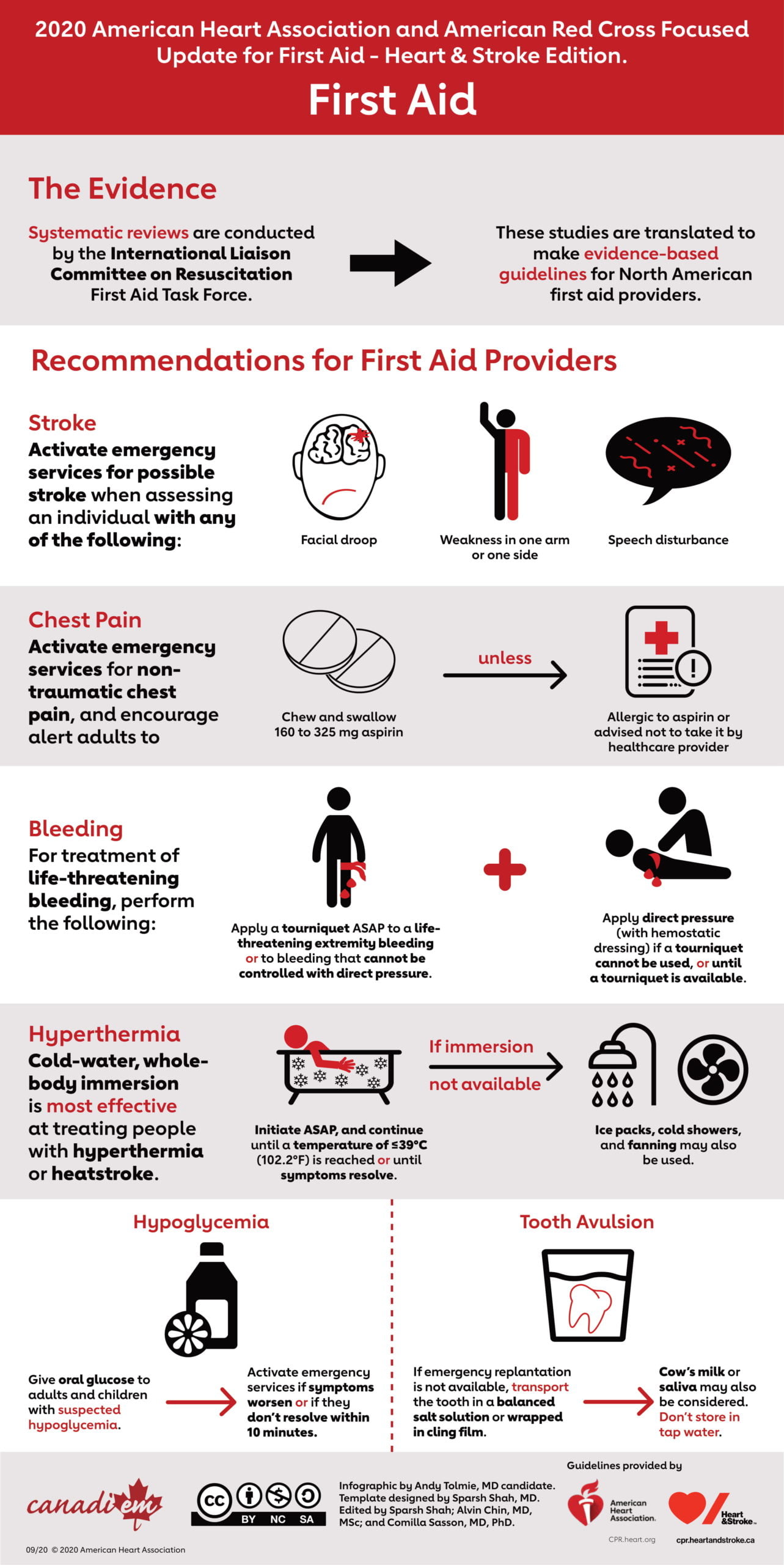This year, the American Heart Association released the updated 2020 Guidelines for Cardiopulmonary Resuscitation and Emergency Cardiovascular Care; the first major update to the internationally recognized guideline in five years. CanadiEM has worked alongside the AHA to produce infographics summarizing these updates.
Alongside the American Red Cross, the AHA developed a Focused Update for First Aid outlining the “Top 10 Things to Know” for providers. The update used systematic reviews produced by the International Liaison Committee on Resuscitation (ILCOR) to create recommendations for North American First Aid providers.
The 2020 First Aid update provides new recommendations regarding how to recognize and treat life-threatening bleeding and heatstroke; both topics that were not included in the 2015 update. Furthermore, updates have been made to stroke recognition, and nontraumatic chest pain guidelines, which can potentially improve patient outcomes. Lastly, the 2020 version reiterates the management guidelines of common first aid presentations such as tooth avulsion and hypoglycemia. The top updates in detail are as follows:
- This “2020 American Heart Association (AHA) and American Red Cross Focused Update for First Aid” incorporates systematic reviews conducted by the First Aid Task Force of the International Liaison Committee on Resuscitation (ILCOR). Systematic reviews conducted by ILCOR provided up-to date science for international use and translated for the North American Guidelines.
- First aid providers can use the signs of weakness in the face (e.g. droop), arm or grip on one side of the body, or speech disturbance to identify individuals with possible stroke and should active emergency services when this occurs.
- After activating emergency services, first aid providers may encourage alert adults experiencing nontraumatic chest pain to chew and swallow 162-324mg of aspirin, this recommendation applies to all adults except for individuals who have an aspiring allergy or individuals who have been advised by healthcare provider not to take aspirin. .
- Alert adults and children with suspected hypoglycemia should be given glucose to swallow. If symptoms worsen or do not resolve within 10 minutes, emergency services should be activated.
- Tourniquets should be used as soon as available for the treatment of life-threatening extremity bleeding or bleeding that cannot be controlled with direct pressure.
- Direct manual pressure, with the use of a hemostatic dressing if available should be used for treatment of injuries with life-threatening bleeding not amenable to the use of a tourniquet, or for extremity bleeding until a tourniquet is available.
- Following avulsion of a permanent tooth, emergency replantation of the rinsed tooth is often the most appropriate treatment, however, when this is not available the avulsed tooth can be transported in Hanks’s Balanced Salt Solution or oral rehydration salt solution or wrapped in cling film to prevent dehydration. If these are not available cow’s milk or saliva may be considered. The avulsed tooth should never be stored in tap water.
- For people experiencing exertional hyperthermia or heatstroke, cold-water, whole body immersion is the most effective technique for rapidly reducing core temperature and should be initiated as soon as possible and continued until a temperature of < 39°C (102.2°F) is reached or resolution of signs and symptoms of heatstroke occurs. If cold-water, whole-body immersion is not available, other forms of cooling, such as commercially prepared ice packs, cold showers, and fanning, may be reasonable.


Further reading:
Heart & Stroke 2020 Guidelines for CPR and Emergency Cardiovascular Care
American Heart Association 2020 Guidelines for CPR and Emergency Cardiovascular Care





